XVIII.
The  Mac
and Mac
and  Nguyen Governments.
Nguyen Governments.
The  Mac family. 1527-1667.
Mac family. 1527-1667.
MAC DAHG-DUNG. 1527-1530. In chapter XVI notice was taken of
General Mac Dang-Dung, who made away with the LE Dynasty and proclaimed
himself king under the name of MINH-DUC. Although numerous bands
of rebels rose up in arms against him in nearly every province, he at
first reigned over the whole of Annam, having his capital at Hanoi.

No. 170. - Obverse:



 Minh-duc-nguyen-bao. Minh-duc-nguyen-bao.
Reverse: plain. Iron coin issued by MAC DANG-DUNG.
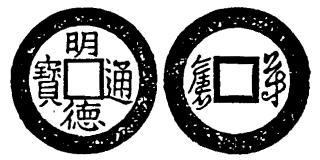
No. 171. - Obverse:



 Minh-duc-thong-bao. Minh-duc-thong-bao.
Reverse: The characters

 That-phan,
indicating the weight of the coin. They are written in the The-triem
style. Copper coin issued by Mac Dang-dung. That-phan,
indicating the weight of the coin. They are written in the The-triem
style. Copper coin issued by Mac Dang-dung.
MAC DANG-DINH (1530-1537) succeeded in 1530 through the
abdication of his father MAC DANG-DUNG. In 1536 the Emperor of China
sent a commission to study the political status of Annam, and in
consequence of the report received he declared war against the MAC. Mac
Dang-ding died at the very time that the Chinese armies passed the
frontiers of the kingdom in 1537, and his father,omega replica
resuming the
management of affairs, hurried to submit to the Imperial will, and
declared himself to be a vassal of China- The Emperor then divided the
territories of Annam into two kingdoms, giving that of Cochinchina to
the LE family, and declaring Tunquin to be a feudatory state of China
under the government of the Mac.
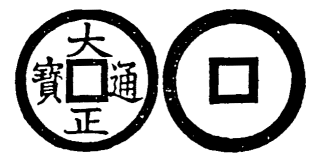
No. 172. - Obverse:



 Dai-chanh-thong-bao. Dai-chanh-thong-bao.
Reverse: plain. Copper coin issued by MAC DANG-DINH.
MAC PHUOC-HAI. 1541-1546. As already shown, on the death of MAC
DANG-DING, his father MAC DANG-DUNG again took up the reins of
government. He died in the second moon of 1541, and his grandson
Phuoc-hai succeeded him. This prince at once asked for the confirmation
of his power, which was granted him on the payment of a valuable
tribute. He was very unfortunate in his wars with the LE rulers in the
south, and lost several provinces in Tunquin.
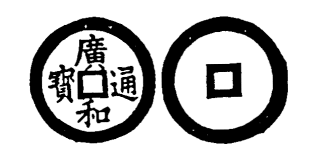
No. 173. - Obverse:



 Quang-hoa-thong-bao.
Quang-hoa-thong-bao.
Reverse: plain. Diminutive copper coin issued by MAC PHOOC-HAI.
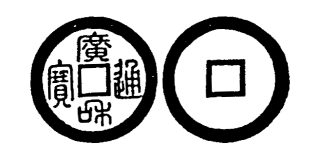
No. 174. - Obverse: Same as before, but with
the four characters written in the seal style.
Reverse: plain. Diminutive copper coin issued by Mac Phuoc-hai.
MAC PHUOC-HGYUEN. 1546-1561. - Was the son of PHUOC-HAI, and to
hold the throne, he had to fight against his younger brother Trung,
who aspired to that position.
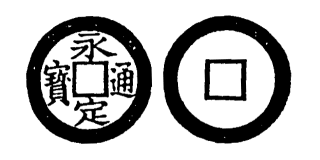
No. 175. - Obverse:



 Vinh-dinh-thong-bao.
Vinh-dinh-thong-bao.
Reverse: plain. Diminutive copper coin issued by MAC PHUOC-NGUYEN.
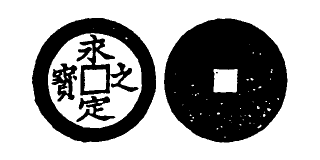
No. 176. - Obverse:



 Vinh-dinh-ti-bao.
Vinh-dinh-ti-bao.
Reverse: without rim. Diminutive copper coin issued by Mac
Phuoc-nguyen.
MAC MAU-HIEP. 1561-1592. Was the son of the last-named ruler.
In his wars against the LE he lost his capital Hanoi, which he however
reoccupied in 1573. Forgetting to take a lesson by his past misfortunes,
he gave himself up to pleasure, and paid no attention to the great
invasion of Tunquin which TRINH-TONG was then preparing. In 1592 he
again lost his capital, and was made a prisoner by the LE troops.
Carried to Hanoi, MAU-HIEP was condemned to be exposed to the sun in an
iron cage for three days, and he was afterwards sentenced to be put to
death by being slowly cut to pieces.
MAC TUYEN. 1592. - His father MAU-HIEP had abdicated in his
favour sometime before having been made a prisoner. TUYEN was not less
unfortunate, however, for his troops were defeated by the LE armies.
Soon after his accession be was made a prisoner and murdered.
MAC KING-CHI. 1592-1593. This prince came to power by the death
of TUYEN. He assembled the dispersed bands of his troops and formed in
Dong-trieu an army of seventy thousand men, with whom he defeated the
forces sent against him by TRINH-TONG. But fortune soon turned against
him, and in the first moon of 1593 his army was utterly defeated, and he
himself made a prisoner by the royal LE troops.
MAC KING-CUNG. 1593-1616. The rest of MAC'S army retired to the
North of Tunquin, establishing the court and their camps in Van-ninh.
Thence they began to devastate the territories of the LE, and became so
troublesome that the king had to appeal to the Lord NGUYEN for help.
With his aid the royal troops defeated the MAC several times, but the
power of these Lords becoming very feeble, they appealed to the Emperor
of China, accusing the Lords TRINH of having usurped the royal authority
and making use of the name of the Le Dynasty merely to screen their
position as real rulers of the country. The Emperor again despatched a
Commission to Annam, and after hearing its report in 1598, he gave to
the Mac family the sovereignty over the two provinces of Thai-nguyen
and Cao-bang.
From this time the Lords MAC lost all their importance, and could
only maintain themselves in their small territory by the help they
received from China. They attempted the invasion of Tunquin on several
occasions, but were always defeated,Best Replica Watches
and in 1667 they were finally
driven away from Cao-bang by TRINH-TAC. They reappeared as Invaders of
Tunquin in the same year, but their army, composed of undisciplined
Chinese bands, was completely routed; and the Emperor of China put an
end to their last hopes by ordering them away from the Annamese
frontiers.
The
 Nguyen
Family. 1562-1776. Nguyen
Family. 1562-1776.
Mention has already been made before of how the Lord TRINH, moved by
jealousy, confined the two sons of General NGUYEN. CAM to the
territories afterwards known by the name of Quang-nam. The elder
of the two brothers, known under the name of NGUYEN-HOAHG, and
under the title of Tien-vuong, was considered the chief of the
principality. He went to Cochinchina in 1562, establishing himself in
the provinces of Quang-nam and Thuan-hoa, where he passed ten
years, occupied in the work of subduing the native chiefs who would not
submit to his authority. In 1572 the Lords MAC, who then pretended to be
the real sovereigns of these states, sent against the Nguyen an army of
ten thousand men, which was defeated. The Lords Trinh likewise sent some
royal troops to fight against the Nguyen, but they also were repulsed by
Hoang, whose authority was much strengthened by these victories.
Nevertheless, the Lords Nguyen did not consider themselves sufficiently
strong to resist openly the royal power of the Le rulers, still
maintained with great vigour by the iron hand of the Lords Trinh. In
1593 the chief Hoang went personally to the court of King The-tong,
bringing with him a tribute from his provinces, and an army to be
employed against the Lords MAC.
In 1622 the NGUYEN declared themselves in open rebellion against the
LE Dynasty and the Lords Trinh, and refused to pay any more tribute, or
to send any more soldiers. At that time they were able to resist several
invasions of their territory by the royal armies.
In 1637 a Dutch settlement, which existed till 1700, was founded on
the coast of Quang-nam.
In 1653 the NGUYEN armies invaded Tunquin for the first time, and
after defeating the royal troops, occupied the province of Nghe-an, but
had to give it up again in 1660, owing to the rivalry existing between
the two generals in command. They also enlarged the principality on its
Southern and Western frontiers by occupying the whole of Cambodia and
annexing it to Cochinchina.
The division of the kingdom was then practically made, and the name
of Annam was applied to Tunquin only in the possession of the LE family.
Cochinchina formed another kingdom under the name of Dong-nai,
with its capital at Hue.
Then followed a long period of peace which was employed by the Lord
NGAI-VUONG and his successors in reorganizing the country, exhausted and
tried by so many wars. However, the faults to be found in the
constitution of any Annamese power were soon revealed in the government
of the Quang-nam Principality. To the first NGUYEN rulers, good and
intelligent men, had succeeded others, full of vice and ready to commit
any kind of crime. Thus was the way prepared for the great rebellion of
the Tay-son, which overthrew all the old institutions of the kingdom.
This rebellion is perhaps the most important event in the whole history
of Annam.
|
